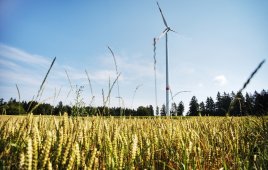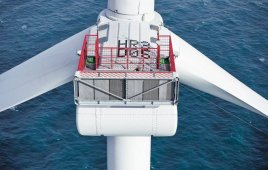Digitalization affects nearly all stages of a wind farm’s lifecycle. Software simulations and analytics are helping wind planners and owners maximize turbine placement and project developments. Smart sensors and IoT-connected monitoring software mean wind turbines can often self-diagnose or predict component failures before they happen. It makes sense for wind owners to leverage a similar digital platform to optimize financial costs, gains, and long-term project plans. Enter the world of “fintech,” or financial technology.
“Fintech is simply the application of modern technology to any sort of financial process or project, including renewables such as wind and solar energy,” explains Benjamin Cohen, the Founder and CEO of T-REX, an enterprise solutions provider for renewable energy project finance. “The end goal is to manage risk, improve capital costs, and maximize those important returns on investment.”

A cash flow report of a wind energy portfolio. By eliminating manual processes and automating workflow, a quality fintech platform can offer wind developers and project owners speed, efficiency, and security across all of their financial investments.
Much like a wind turbine’s predictive monitoring software, a quality fintech platform collects, manages, and analyzes data, providing users with suggestions to optimize their project. “However, in this case, the aim is to optimize a project’s financial health rather than its asset health.”
According to Cohen, there are two reasons this is important in the current renewables’ market. The first is operating capacity.
“It is virtually impossible for humans to match the speed and performance of a fintech program by using conventional financial models or programs.” He says T-REX’s QA backend software runs over 2,000 automated checks on calculations in the platform. One benefit of such scrutiny: “A wind operator could ensure a project’s revenue-driven O&M costs are adjusted for every power purchase agreement nuance in an hourly PPA contract.” Given that wind PPAs are dynamic contracts, financial models should account for variability such as fluctuating O&M costs.
Here’s a simple example: “A wind developer projects an annual revenue of $100 for a PPA with a set O&M cost of $5. If year one of the contract generated only $90, O&M costs should be adjusted to commensurate with the revenue — so to $4.50.” Cohen says a fintech platform’s “analytical engine” must be built for such PPA nuances to provide precise risk and financial analysis.
The second reason relates to the nature of renewable energy. Fintech is particularly helpful to investors and owners of wind projects, which may produce variable returns depending on energy demands and winds. “Given the variable nature of renewables, typical project finance tools are unable to provide the analytical precision required to properly assess and price related financing risk,” says Cohen. “As a result, many high-potential projects fail to receive adequate funding.”
The problem is typically one of data management. “Many of our clients already have a wealth of data, but are unable to fully sort through or leverage their datasets to make the wisest investment proposals or financial decisions,” says Cohen. Proposing a project at a low to medium-speed wind site, for example, may seem too risky to investors without a solid financial model that demonstrates viable returns.

T-REX’s software-as-a-service platform supplants spreadsheet-based workflow and allows collaboration. This means users can invite colleagues or counterparties to share data and collaborate on projects, while assigning a level of seniority based on a recipient’s role.
With a quality platform, however, fintech users can incorporate and analyze information from many different datasets. “In wind, jurisdiction matters. So a wind project in New York will typically present different challenges relating to siting, permitting, logistics, O&M, ROI, and so on than a project in Texas. Ideally, each project requires a different investment strategy, which accounts for every one of those parameters from a financial standpoint,” says Cohen.
“There are also considerations with the production tax credits winding down, and potential tax equity implications depending on where components were purchased. Then, there are insurance cost considerations, and operations and maintenance budgets.” These are different data points but they are all relevant and critical to a project, explains Cohen. “There are typically many areas of fragmentation across an entire workflow, but fintech can analyze each one and streamline the assessment process.”
The goal of investing in fintech is to optimize the capital structure of an asset or portfolio and gain better financial returns. To do so, wind owners must start with a financial platform built for the industry. Here are three questions to ask before choosing one.
1. Is it secure?
Unfortunately, all digital systems are at risk from cyber hackers. However, there are ways to mitigate risks.
“Global investment banks and other big regulated entities, such as utilities, are finding that data living on the cloud is more secure than on their own servers or in an Excel model — which can be downloaded and shared without restriction,” says Cohen. “As a result, our technology lives on Amazon Web Services, which is an outsourced cloud-based software.”
In the current digital era, it is important to verify the security measures of any financial program applied to wind assets. One way to do so is to ask about security audits. “For example, a SOC-2 technology audit is completed by Ernst and Young on our security and software development protocols at least once a year,” he adds.
2. Is it collaborative?
Several parties involved in a wind project may be in different locations. So it is important to find a method to securely pass data or contracts back and forth without time lapses.
“A software-as-a-service, or SaaS, collaboration platform offers many advantages over conventional spreadsheet-based workflow,” says Cohen. SaaS is a method of software delivery that lets users access cloud-based applications or data from any device connected to the internet.
“One essential feature for renewable investments is the ability to quickly and seamlessly share project details with other parties in a transaction. This means standardizing data and eliminating the need for multiple spreadsheets or Excel models,” he says. SaaS lets users do just that. It also ensures the most recent document is accessible to each party at all times, so if changes are made they are not lost in the shuffle.
“Accurate, attainable data and clear communication are critical to successful partnerships and investments.” Cohen recommends a cloud-based platform that lets users collaborate efficiently and more securely at each stage of the investment lifecycle.
“Just make sure the fintech platform you choose has a built-in controls, such as the ability to permission participants based on their role in a deal,” he says.
3. Is it bankable?
Reliability is one key to a quality fintech platform. However, it must also have the capacity to handle complex dataset calculations and simulate outcomes based on numerous inputs.
“Wind developers and financiers rely on multiple variables to make wise, bankable decisions. So analytical precision is key to risk mitigation,” says Cohen. “That means fintech must accurately account for multiple nuances — whether it is the variability of wind, unexpected O&M costs, or the fine print on a PPA — the more detailed an analysis the better.”
When choosing a financial platform, ask about its ability to manage inputs, analyze data, and perform checks and balances. “An efficient, reliable, and comprehensive fintech platform is a bankable one,” says Cohen.
To learn more about financial technology and how it can help wind developers and project owners, listen to this podcast with Benjamin Cohen.
Filed Under: Financing, News, Projects




